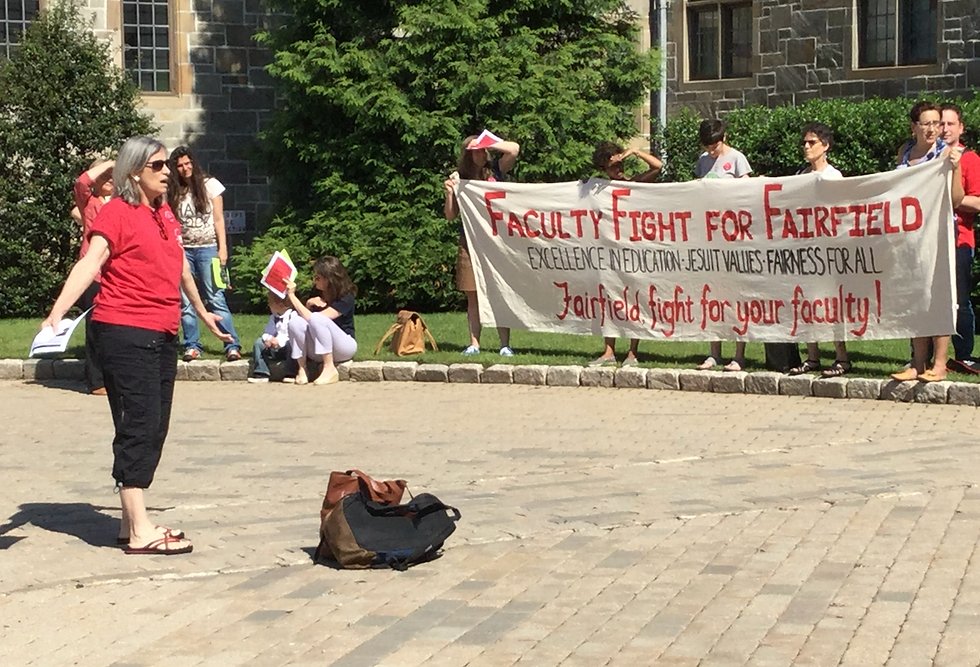
I'm a paragraph. Click here to add your own text and edit me. It’s easy. Just click “Edit Text” or double click me to add your own content and make changes to the font.
ABOUT
The FACULTY WELFARE COMMITEE
What is AAUP?
1972
An "Old-Timer's Perspective" by Arthur Anderson, Sociology Dept., published in the FWC newsletter, Feb. 21, 2005.
Thirty-three years ago there was strong growing concern among the faculty as to how their wages and benefits were determined and how they were given out. Persistent rumors alleged that the Dean at that time had a shoe box of money in the top drawer of his desk which he drew on to provide “merit pay” to faculty supplicants who dropped by his office. The rumors were supported by faculty who bragged about receiving such “merit increments."The overall system was a top-down – and difficult to understand – process.
Faculty discontent grew until five untenured assistant professors developed a “Faculty Salary Committee” and I was honored to be a member of this risky venture. Data was collected and presented to the administration, noting various inconsistencies, such as the fact that there were assistant professors earning more than some tenured full professors. Such findings increased faculty discontent to the point that the majority supported the “Faculty Salary Committee” becoming a defacto bargaining group to meet with administration representatives to discuss and jointly agree on
faculty salaries and benefits.
Enough of the administration leaders were sufficiently alarmed at the degree of faculty discontent that they agreed to proceed with such an arrangement.
What were the benefits of this new arrangement? Faculty morale and self-respect significantly improved. Faculty respect for the administration also improved, because faculty believed the administration was determining important things such as compensation in an open forum of mutual respect.
As a sociologist I would note that the new arrangement did very positive things for the entire university because it successfully institutionalized a fundamental and critical aspect of the faculty/administration relationship. The new arrangement worked. It got an important job done. It did good things for both faculty and administrators.
And where are we today? We are in the process of reestablishing the typical businesslike, top-down, authoritarian model we replaced 33 years ago. From the point of view of fostering good morale and mutual respect, present proposals and dictates are on the verge of destroying an overall successful relationship between the faculty and administration on the important issue of compensation.
I have loved my thirty-seven years as a member of Fairfield’s faculty, and I have appreciated being part of the growing academic excellence of this University. I must add, however, that as I retire this coming June I am saddened that the faculty/administration relationship is rapidly moving backwards – over thirty five years backwards – to a relationship model that I foresee as negatively impacting the goals and objectives of this very fine university.
1989
Solidarity in Action 2014-2023.
The Faculty Welfare Committee was founded in 1989 as a chapter of the AAUP to build on the
unifying the faculty, building committee structures, and even picketing around Bellarmine, walking a circle with signs. A culture of resistance, of awareness, of transparency, and true shared governance was built slowly. A piece of that history hangs in Donnarumma on the first floor, at the corner near the elevator. If you look, you’ll see a hand-stenciled sign that says “FWC” and is signed by colleagues who helped to found the organization and who risked a lot for it—together. Most of those folks are retired, but that sign hangs as a strong reminder of faculty power and what it does for us—and only with our participation--every day.
This is what your paycheck means: solidarity and organizing through committees and years of long tedious meetings, using the tools offered by the American Association of University Professors, including the annual salary survey, which we have used as a benchmark to tie our current compensation to national averages.
Fairfield faculty through the FWC are a collective bargaining chapter of the AAUP, which recognizes the union-like structure and strong participation that has won real gains.
In the Fairfield Mirror.
-
March 20, 20114: "Different Perspectives to a Blurry 2020"
-
Dec. 2, 2014: "Letter to the Editor: Fairfield Lacks Transparency"
-
May 8, 2015: "Faculty Protest Healthcare Options"
-
Nov. 11, 2015: "Labor Issues Surface on Campus"
-
Dec. 9, 2015: "Solidarity Wins Janitorial Staff Old Shift Back"
-
April 27, 2016: "Campus Workers Unite to Express Complaints at Forum"
-
March 29, 2017: "Fairfield Gathers to Support Worker Rights"
-
Dec. 5, 2018: "Students Stand in Solidarity with Custodians"
-
June 26, 2020: "Stags Come Home: Who's Actually Making the Decisions for Reopening in the Fall?"
-
July 30, 2020: "Covid-19 Brings Fairfield's Finances into Question"
-
Nov. 3, 2021: "Faculty Express Need for Covid-19 Vaccination Mandate"
-
Feb. 24, 2022: "Faculty Take a Stand Against Administration's Removal of Black Lives Matter Flags"
-
Dec. 3, 2023: "Facilities Union Protesters Urge Nemec to Support Workers"




